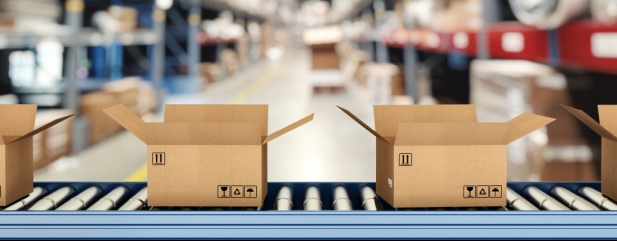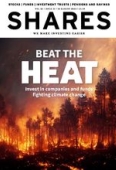Archived article
Please note that tax, investment, pension and ISA rules can change and the information and any views contained in this article may now be inaccurate.
How packaging companies are positioned for the shift away from plastic

If we think about what packaging companies do, probably the first thing that comes to mind for most of us is getting a brown cardboard box or envelope through the post from Amazon (AMZN:NASDAQ) with its tell-tale smiley logo.
Yet e-commerce is just a small part of the overall business of firms like DS Smith (SMDS), Mondi (MNDI) and Smurfit Kappa (SKG), who together dominate the European market for card and cardboard.
Packaging for food and other fast-moving consumer goods makes up around 75% of sales for the industry on average, and for some firms the mix is even higher.
So, what can be done about replacing the amount of plastic used in food and drink packaging for instance? And which companies stand to benefit from this trend?
SUPERMARKETS TAKING THE LEAD
As part of its push for sustainability, the UK’s biggest grocery chain Tesco (TSCO) uses what it calls ‘The Four Rs’ – Remove, Reduce, Reuse and Recycle – to cut its use of plastic packaging.
It removes plastic where it can, reduces it where it can’t, reuses a growing proportion and recycles what’s left.
The company claims packaging ‘is at the top of customers’ priorities for a reason’ – namely that it accounts for 70% of the UK’s plastic waste – and it has removed nearly 2.2 billion pieces of plastic from its business.
Multipacks of tins and bottles are no longer wrapped in plastic but in cardboard, and Tesco has sent all its suppliers a green list of nine easy-to-recycle materials which it encourages them to use for packaging while pressing them to stop using PVC, waxed or siliconised paper, polystyrene, MDF and other non-recyclable materials.
The trickiest area to use cardboard instead of plastic is in fresh food, but even here supermarkets are learning new tricks with salads and fresh vegetables now available in brown cardboard pots or breathable containers.
PASSING THE ‘PAPER STRAW TEST’
Kira Bindrim, editor of Bloomberg’s Greener Living newsletter, says consumers are generally happy to try new ways of shopping and living greener, even if it costs a few pence extra.
‘If you ask people whether they’re willing to change their buying habits in the interest of helping the planet, most of them will say yes; many will even say they’d spend more money to do it.
‘In practice, though, it really helps if a sustainable solution also costs less, is more convenient or is simply cool to adopt. Fortunately, more products in more places are moving in that direction.
‘There’s a common misconception that changing how you live in the interest of the climate is synonymous with sacrifice. That decarbonising always means downgrading. I call this the Paper Straw Conundrum, because few products do more than paper straws to convince people sustainability means embracing solutions that suck.’
DS Smith, which makes 86% of its sales to the fast-moving consumer goods industry, has long been at the forefront of using cardboard instead of plastic, from its trays and shelf-ready packaging solutions to point-of-sale display stands.
The firm estimates over 70% of shoppers’ decisions are made after customers have entered the store, and in a highly competitive environment like food retail, packaging has to make the product look attractive as well as functioning properly.
Its Ecovete cardboard punnets replace plastic trays for fruit and vegetables, while its Eco Bowl for fresh, chilled or frozen meat and fish lowers the use of plastic by 85% without reducing shelf life and is easily recyclable.
In the last year, DS Smith has helped its customers replace 300 million pieces of plastic packaging with fibre-based alternatives, and by 2025 it aims to have removed 1 billion pieces of ‘problem’ plastic from supermarket shelves.
Its in-house team of 700 designers has already created over 1,000 new designs for millions of products, allowing customers to take plastic out of the packaging process.
HOW BIG IS THE MARKET?
According to the OECD (Organisation for Economic Cooperation and Development), even if the amount of plastic that is recycled doubles between now and 2060, the amount of plastic waste produced globally is on track to almost triple, with around half ending up in landfill, a third being incinerated and less than a fifth being recycled, as the global population and incomes increase.
Two-thirds of that waste is expected to come from short-lived items like packaging, low-cost products and textiles. Despite developing and emerging economies growing faster, developed countries will still produce much more plastic waste per person (238kg per year, on average) than developing countries (77kg per person, per year).
Today, the amount of plastic waste being created each year weighs around 300 million tons, or the same as the entire human population, and half of that total is single-use plastic which is thrown away the minute it has been used.
The OECD suggests there should be taxes on plastics, including packaging, targets for recycled content in new plastic products, increased litter collection and improved waste management infrastructure.
Yet even a small change, like swapping plastic sealing tape with self-locking tabs or printing directly onto cardboard rather than using plastic labels, could make a big difference if it were scaled up.
WHAT IS AMAZON DOING?
The world’s largest retailer knows its customers want their orders delivered in right-sized, easily recyclable packaging that ensures the product arrives undamaged and with minimal impact on the environment.
Amazon says it has eliminated the use of more than 1.5 million tons of materials since 2015 despite the number of shipments having grown significantly.
It has already moved away from plastic packaging in most of its major markets including Europe, India, Japan and Australia, with the volume of single-use plastic used across its global operations network (i.e., orders shipped through its own fulfilment centres) down 11% last year from around 97,000 tons to less than 86,000 tons.
It has also reduced its use of corrugated boxes by over 35% in North America and Europe over the last five years by switching where possible to padded mailers and bags which are up to 75% lighter.
Last month it made a further commitment to reduce plastic use in the US by phasing out its ubiquitous blue and white and other plastic mailers which are not accepted by most curb side recycling collections in favour of alternative solutions including lightweight paper-padded mailers.
That decision will significantly reduce the company’s plastic footprint, given that pouches and bags represent over 30% of e-commerce plastic packaging globally.
ARE SHARES IN PACKAGING COMPANIES WORTH BUYING?
The valuations of DS Smith and Mondi have come down a long way in the last five years, with both stocks trading well below their mid-2018 highs and their (pre-pandemic) February 2020 levels, while Smurfit Kappa has led more of a charmed life, only peaking in 2021 and still well above its pre-pandemic value.
Fears of profit warnings due to high energy costs following the invasion of Ukraine, soaring interest rates and destocking by customers in anticipation of lower prices to come, have seen shares in
DS Smith and Mondi de-rated to the point where their current valuations are between 20% and 25% below their mid-cycle average according to analysts at broking firm Davy.
‘With destocking easing, European box demand has troughed,’ they argue, while ‘progressively easing second-half 2023 comparators provide a path to 2024 packaging demand growth’.
The analysts expect consensus earnings estimates to rise, helped by lower energy and raw material costs, leading to a re-rating in the second half of this year.
Smurfit Kappa reported first-half earnings on 2 August, with EBITDA (earnings before interest, tax, depreciation and amortisation) of €1.1 billion, down 5% on last year, due to a 6% fall in box volumes.
Analysts at US investment bank Morgan Stanley concur that earnings across the sector are likely to be lower in the first half, but argue much is already priced in and, with the margin cycle now at the bottom, this is the time to invest.
The team’s pick is Mondi, which described its half-year results on 3 August as ‘delivering in challenging markets’. The company said: ‘Whilst underlying EBITDA was lower, the business exhibited its strong cash generative characteristics, improving cash generation.
‘So far in 2023, demand and prices have declined sequentially with the exception of containerboard prices which stabilised in the later part of the half year. We saw some benefit from lower input costs which continue to ease as we progress into the third quarter of the year.
‘We remain focused on improving productivity and efficiency, while expanding capacity in our growing packaging segments. We have a compelling portfolio of sustainable packaging and paper products, scale and a resilient business model, which position us well to deliver attractive returns and sustainable value accretive growth.’
DS Smith isn’t due to update the market until its first quarter results at the beginning of September, but the team at Davy see pricing staying ‘resilient’ in spite of lower volume demand while lower costs feed through into higher margins.
In its full-year results in June, the firm demonstrated strong pricing power, lifting its operating profit by 40% to £861 million and showing that meeting customer demand for more sustainable products can also improve margins.
Clive Beagles, manager of the JOHCM UK Equity Income Fund (B03KR61), is another fan of DS Smith. Speaking to Shares in June, he said: ‘People were concerned about a destocking phase in the packaging industry after paper prices went up because of higher energy prices following the Ukraine war, and they are now coming down because customers think prices will fall.
‘In fairness, volumes have been a little bit softer but it feels to us as if that destocking phase is pretty much done. It’s been going on for six to nine months, which is about the right duration.
‘The thing that excites us is the opportunity for volume growth to come from the switch away from plastic towards cardboard in food packaging. The vast majority of fresh food in supermarkets is wrapped in plastic, but the coatings that cardboard bring are getting better and better, and in time I suspect meat and fish will be predominantly cardboard-packed.
‘We think food packaging can add 1% to 1.5% to annual volume growth in an industry that isn’t particularly high-volume growth and tends to ebb and flow along with GDP. That tailwind could easily last a decade and it isn’t being priced in as DS Smith trades on just nine times forward earnings.’
Important information:
These articles are provided by Shares magazine which is published by AJ Bell Media, a part of AJ Bell. Shares is not written by AJ Bell.
Shares is provided for your general information and use and is not a personal recommendation to invest. It is not intended to be relied upon by you in making or not making any investment decisions. The investments referred to in these articles will not be suitable for all investors. If in doubt please seek appropriate independent financial advice.
Investors acting on the information in these articles do so at their own risk and AJ Bell Media and its staff do not accept liability for losses suffered by investors as a result of their investment decisions.
Issue contents
Editor's View
Feature
Great Ideas
News
- Investors are proving to be wary about new US float SharkNinja – here's why
- Why forecasters are dumping US recession predictions en masse
- What do Wilko’s woes mean for retail property shares?
- Insurance giant Aviva set to deliver on its growth targets
- Ukrainian miner Ferrexpo down 82% in two years on the stock market
- Marks & Spencer share price at highest level since January 2022

 magazine
magazine








